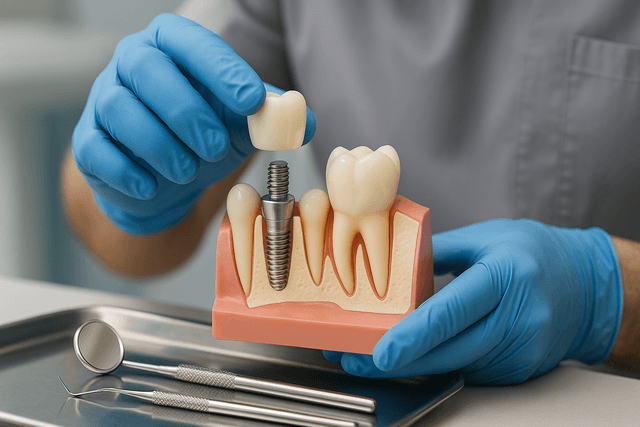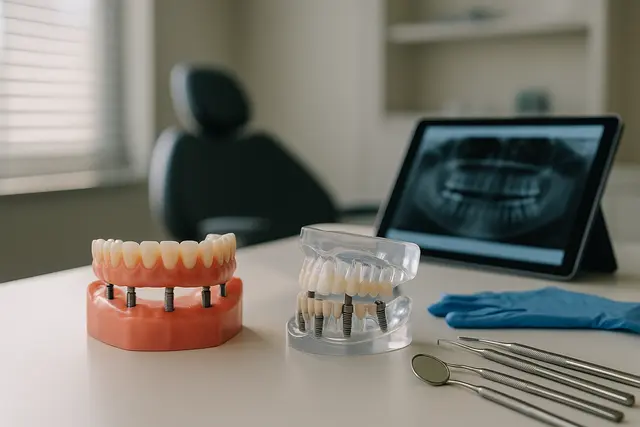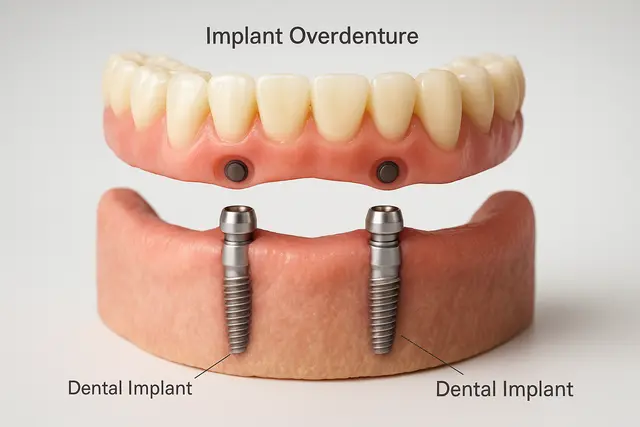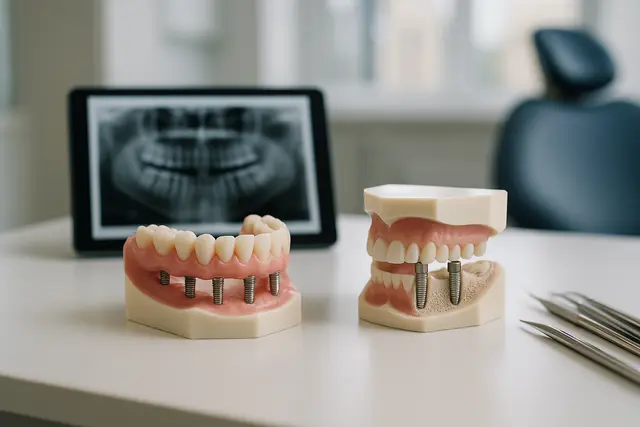Prosthodontics
6 min read
Oct 09, 2025
Dental Implant Screw Loosening: Causes and Fixes
Dental implants are one of the most reliable ways to restore missing teeth, but even these high-tech solutions can run into problems. One of the most common and overlooked issues? A tiny screw that loosens over time, potentially compromising the entire implant structure. Understanding why this happens is key to keeping your implant secure and functional.

If you've ever had a dental implant and noticed something doesn't feel quite right, maybe your bite feels off, or there's a slight wiggle, there’s a good chance the culprit is something tiny but mighty: the screw. Yep, that little piece of metal that holds your smile together can stir up some serious drama when it decides to go rogue.
Screw loosening isn’t just annoying. It can mess with your comfort, your oral health, and in some cases, the success of your entire implant. So let's unpack why this happens and what you (and your dentist) can do about it.
Screw and the Silent Trouble It Can Cause
In implant dentistry, the screw is the unsung hero holding your implant crown to the abutment or implant body. When that screw loosens or fails, everything else is at risk of following suit.
Screw loosening occurs when the implant screw that holds the abutment and crown together gradually unwinds or loses torque over time. This doesn't usually happen overnight. It often sneaks up after months, or even years, of everyday chewing, clenching, and living your best life.
But here's the thing: when a screw is tightened properly during the dental implant treatment, with the right torque, it should stay put. So what gives?
Dental Implant Woes and the Usual Suspects
A dental implant is meant to be a long-term fix to replace missing teeth. But even the most advanced implant system isn't immune to the occasional hiccup. Let's talk about the most common cause of screw loosening.
One word: torque. If the torque applied during implant placement is too low or not retained, the screw joint can gradually lose tension. When this happens, the implant components start to move under pressure. This movement is what eventually leads to screw loosening.
Now, factor in things like:
A poor fit between the implant abutment and crown
Chewing forces placed on the implant
Improper implant placement
...and you’ve got a recipe for trouble.
Implant Screw and the Domino Effect
An implant screw might seem insignificant, but when it starts to shift, so does everything else. The crown and the abutment may begin to rock slightly. The screw head might even deform. This micro-movement creates repeated stress on the implant components, leading to screw failure or, worse, implant fracture.
The scary part? Many patients don’t notice anything until their implant crown feels loose or, in extreme cases, the entire implant screw falls out. Talk about a dental horror story.
Crown Fit Matters More Than You Think
A well-fitting implant crown isn't just for aesthetics. It helps maintain the stability of the implant. If the crown doesn't mesh properly with the abutment, even the best dental care won't stop it from becoming a weak point in your implant restoration.
A misaligned or overly high crown can cause uneven forces during chewing, which put extra pressure on the screw joint. This force can gradually lead to abutment screw loosening or, worse yet, screw fracture.
The Common Cause of a Loose Dental Implant
If you're experiencing a loose dental implant, it's easy to fear the worst. But more often than not, it's not the implant body that's failed. It's the abutment screw that’s come loose. Thankfully, that's a fixable issue, if caught early.
The most common cause of a loose implant screw is insufficient screw preload. Preload is the tension created when a screw is tightened. Think of it like the stretch in a rubber band. If that stretch isn't enough, the screw may not hold under pressure.
And yes, this happens more than you'd think. The incidence of abutment screw loosening varies but is reported to be one of the top dental implant complications. Especially in high-stress zones like the back molar implant sites.
Screw Loosening and the Clues You Shouldn’t Ignore
So how do you know if something’s up with your tooth implant?
If your implant feels slightly wobbly, or you hear a faint clicking when you bite, that could be a sign of screw loosening. In some cases, food debris can get trapped around the implant, making it even harder to keep up with your oral hygiene.
Left unchecked, a loose screw may wear down the internal threads of the implant, leading to permanent damage. Worse yet, a dental implant screw that loosens repeatedly might hint at deeper issues with the implant components or placement.
Dental Implant Screw Falls Out, Then What?
It’s rare, but yes, sometimes the dental implant screw falls completely out. This might look like a tiny piece of metal you find in your food (ugh) or something you notice missing after brushing.
When this happens, don't panic, but don’t delay either. Call your dentist. The implant site must be cleaned, and the components examined. If the threads within the implant haven’t been damaged, a new abutment screw can usually be placed and tightened with the correct implant torque.
Implant Failure and When It’s More Than a Loose Screw
Occasionally, screw loosening can be a red flag for something bigger, like early implant failure. If there’s bone loss around the implant or signs of infection, replacing the screw won’t solve the issue.
Dentists will often take X-rays to evaluate the surrounding bone and check for any signs of implant fracture or infection. If caught early, corrective procedures can be done to save the implant. If not, it may require removal and possible re-treatment later on.
Fracture and the Dreaded Broken Screw
If you’ve got a fractured screw, you’re entering trickier territory. A fracture of the screw can occur from repeated overload or improper torque during placement.
Removing a fractured screw is one of the more frustrating procedures in implant dentistry. Sometimes, special kits are used to extract broken pieces. In worst-case scenarios, the entire implant body might have to be removed.
To reduce the risk of screw fracture, dentists must follow precise torque guidelines from the implant manufacturer and ensure the crown, abutment, and implant system are all properly aligned.
Dentist Tips for Preventing Screw Failure
The good news? Most cases of screw failure are preventable.
Dentists trained in restorative dentistry at the university level (and beyond) are taught to follow meticulous protocols. This includes:
Selecting the right abutment connections
Applying the correct torque
Ensuring ideal occlusion (how your teeth come together when you bite)
Patients can help too. Keeping up with dental hygiene, avoiding grinding habits, and sticking to regular checkups will go a long way in preserving your implant.
Implant Crown Choices and How They Affect Outcomes
There are two main types of implant crowns: cement-retained and screw-retained implant restorations. Each has pros and cons.
A screw-retained implant makes it easier to access and replace components if something goes wrong, but it also means you have a visible access hole that must be sealed properly.
Cement-retained implant crowns offer better aesthetics but can be more challenging to remove if the screw loosens.
Whichever you go with, proper fit and placement are key.
Implant Complications and Why You Need a Pro
There’s no sugar-coating it, dental implant complications are frustrating. But working with experienced dental professionals who understand the biomechanics of implant systems and screw joint stability makes all the difference.
It’s not just about placing a screw. It’s about understanding how the implant and surrounding structures interact and how to optimize for long-term success.
Implant Components and the Importance of Integration
Integrated dental implant components vital to predictability are chosen carefully by your dentist based on your anatomy, bite pattern, and even lifestyle. Whether it’s a single implant or a full-mouth restoration, every part, from the screw to the implant abutment screw, must work together.
When implant components aren’t compatible or are poorly fitted, that’s when things start to come loose, quite literally.
Oral Hygiene and the Role You Play
We can’t talk about implant longevity without giving a shoutout to oral hygiene. Poor oral hygiene doesn’t just affect your natural teeth. It’s a major cause of implant complications, too.
Inflamed tissue around your implant can loosen the bond between components and even lead to peri-implantitis, a condition that can trigger bone loss and, ultimately, implant failure.
So brush. Floss. And maybe skip the jawbreakers.
What Causes a Dental Implant Screw to Loosen?
The most common cause of implant screw loosening is insufficient torque or preload during placement. If the screw isn’t tightened properly, micro-movements from daily chewing and grinding can cause the joint to lose stability over time. Other contributing factors include a poor fit between the crown and abutment, improper implant angulation, and excessive bite forces, especially in molar regions.
What Are the Signs of a Loose Implant Screw?
Early signs of a loose implant screw include slight mobility in the implant crown, clicking noises when chewing, or discomfort when biting. In some cases, patients may notice swelling around the implant or even discover the screw has fallen out. If any of these signs are present, prompt dental evaluation is necessary to prevent further complications.
Can a Loose Implant Screw Be Fixed Without Replacing the Implant?
Yes, in most cases, a loose screw can be fixed without replacing the implant itself. If caught early and the internal threads of the implant are intact, the dentist can remove the crown, clean the components, and retighten or replace the abutment screw with the proper torque. However, if there’s damage to the implant body or surrounding bone, more extensive repair or replacement may be needed.
How Can Screw Loosening Be Prevented in Dental Implants?
Prevention starts with precise dental planning and placement. Dentists must apply the correct torque and ensure proper alignment between implant components. Patients can help by maintaining good oral hygiene, wearing night guards if they grind their teeth, and attending regular dental checkups. Avoiding habits like chewing ice or hard foods also reduces mechanical stress on the implant.
Read Next
Related Posts

Prosthodontics
Implant Supported Dentures Overview
Missing teeth can impact more than just your smile, they can affect your confidence, comfort, and even your diet. Fortunately, modern dentistry offers a solution that’s both secure and natural-looking: implant-supported dentures. This innovative approach blends the stability of implants with the convenience of dentures to create a long-lasting, life-improving upgrade.
5 min read
Oct 29, 2025

Prosthodontics
Implant Overdentures Explained: The Hybrid Solution to Missing Teeth
Missing teeth can impact everything from your ability to eat to your self-confidence. While traditional dentures have long been a go-to solution, they often fall short in comfort and stability. Implant overdentures offer a modern alternative that combines the security of dental implants with the convenience of removable dentures, a true upgrade for those looking to reclaim their smile.
6 min read
Oct 29, 2025

Prosthodontics
Implant Retained Dentures Explained
Considering implant-retained dentures? You're not alone. As modern dentistry evolves, more people are turning to this secure, natural-feeling alternative to traditional dentures. This guide will walk you through what they are, how they work, and why they might be the solution you've been looking for.
4 min read
Oct 28, 2025
Don’t have time to research every dentist around you?
See why 30k+ patients trusted us